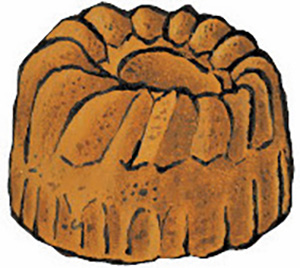
Around Rosh Hashanah time, you can have your cake and eat it too, as long as it’s honey cake. Having honey cake during the High Holidays is something most Jews accept as a given and take for granted, just like when Jews assume that every rabbi enjoys delivering a sermon, every butcher enjoys slicing meat and every bar mitzvah boy enjoys getting pelted with candy. But surely there must be more to the honey cake for it to be so ubiquitous and sought-after in the Jewish world at this time of year.
The Jewish version of honey cake is known as “lekach,” a term derived from the German word for “lick.” (That certainly is better than deriving from the German word for “spit.”) In Hebrew, honey cake is referred to as “oogat dvash,” which literally means honey cake. (Yes, in Hebrew a Strawberry Shortcake could be referred to as “oogat tut katan” and a Seven-Layer Cake could be referred to as “oogat sheva-madregot.”) Honey cake is consumed during Rosh Hashanah because its honey component is meant to symbolize a sweet New Year. Obviously, nobody wants a sour New Year and therefore on Rosh Hashanah Jews usually refrain from eating sour cream or sour-dough bread. A more difficult question is whether it is appropriate on Rosh Hashanah to serve sweet & sour chicken, a dish which arguably would give mixed messages.
Believe it or not, honey cake is expressly mentioned in the Talmud. For example, Pesachim 120a states: “With regard to unleavened sponge cakes, cakes fried in oil and honey, and honey cakes, a person may fill his stomach with them on Passover night, provided that he eats an olive-bulk of matzah after consuming them.” (Yes, “cakes fried in oil” might be a Talmudic reference to heimish churros or zeppole.) Recipes for honey cake differ but some scholars insist that the Jewish version dates back to and derives from an Ancient Egyptian cake known as “basbousa.” Others contend that the Jewish honey cake comes not from a basbousa, but rather from a balaboosta.
For the record, on Rosh Hashanah Jews enjoying dipping apples in honey, not honey cake. (Dipping apples into honey cake would be silly because dipping one solid into another solid would make as much sense as eating a liquid with a fork or cutting a gas with a knife.) On Rosh Hashanah, Jews eat apples and honey as though the two were made for each other, like gefilte fish & horseradish, chopped liver & crackers and herring & onions. (Yes, Herring & Onions would be a great name for a new television drama about two altacocker cops.) Some would argue that if honey is synonymous with having a sweet New Year, it would make more sense to dip honeydew (instead of apples) in honey. That might be way too sweet, kind of like dipping chocolate-covered matzah into Nutella.
On Rosh Hashanah, Jews normally do not usually eat other forms of apples and honey together. For example, Jews do not go out of their way to feast on apple cider and honey mustard or appeltinis and honey roasted peanuts. They also do not jump through hoops to eat both apple and honey-infused baked goods. Apple pies, apple strudel and apple turnovers certainly are available around the High Holidays but they are not typically served alongside honey cake. Truth be told, apples pies, strudel and turnovers simply do not draw the same attention or make the same impact as honey cake. In other words, when it comes to dominating Rosh Hashanah, honey cake takes the cake.
Some scholars argue that, many years ago, the “honey” traditionally consumed on Rosh Hashanah did not come from bees. (By “bees” we mean insects, not spelling competitions.) These scholars claim that such “honey” actually was fruit-based, derived from grapes or dates. (By “dates,” we mean dried fruits, not romantic pursuits. As an aside, a date-bearing tree is known as a Phoenix dactylifera whereas a date-bearing matchmaker is known as a Shadchan dactylifera.) Other scholars insist that honeybee-produced honey first came into fashion when it was discovered by the Greeks in the 4th Century. (By “Greeks” we mean the citizens of the ancient civilization, not the members of collegiate social clubs.)
The Hebrew word for honey is “dvash” and the Torah describes Israel as “eretz zvat chalav u’dvash,” meaning a “land flowing with milk and honey.” The Torah, however, does not mention anything about a land flowing with honey cake. Then again, the Torah does not mention falafel or hummus but Israel certainly flows with them too.
Final thought: To entice guests to join you on Rosh Hashashah, using honey cake as a honey trap is permitted.
By Jon Kranz










